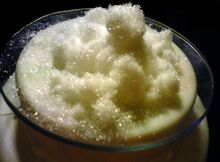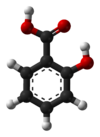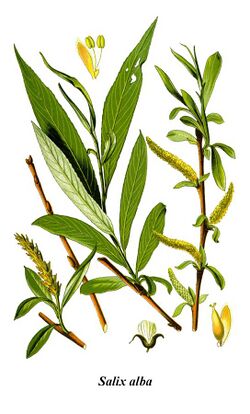Chemistry:Salicylic acid
|
| |||

| |||
| Names | |||
|---|---|---|---|
| Preferred IUPAC name
2-Hydroxybenzoic acid[1] | |||
| Identifiers | |||
3D model (JSmol)
|
|||
| ChEBI | |||
| ChEMBL | |||
| ChemSpider | |||
| DrugBank | |||
| EC Number |
| ||
| KEGG | |||
PubChem CID
|
|||
| RTECS number |
| ||
| UNII | |||
| |||
| |||
| Properties | |||
| C7H6O3 | |||
| Molar mass | 138.122 g/mol | ||
| Appearance | Colorless to white crystals | ||
| Odor | Odorless | ||
| Density | 1.443 g/cm3 (20 °C)[2] | ||
| Melting point | 158.6 °C (317.5 °F; 431.8 K) | ||
| Boiling point | 211 °C (412 °F; 484 K) at 20 mmHg[2][3] | ||
| Sublimes at 76 °C[3] | |||
| Solubility | Soluble in ether, CCl4, benzene, propanol, acetone, ethanol, oil of turpentine, toluene | ||
| Solubility in benzene | |||
| Solubility in chloroform | |||
| Solubility in methanol |
| ||
| Solubility in olive oil | 2.43 g/100 g (23 °C)[3] | ||
| Solubility in acetone | 39.6 g/100 g (23 °C)[3] | ||
| log P | 2.26 | ||
| Vapor pressure | 10.93 mPa[3] | ||
| Acidity (pKa) | |||
| UV-vis (λmax) | 210 nm, 234 nm, 303 nm (4 mg/dL in ethanol)[3] | ||
| −72.23·10−6 cm3/mol | |||
Refractive index (nD)
|
1.565 (20 °C)[2] | ||
| 2.65 D | |||
| Thermochemistry | |||
Std enthalpy of
formation (ΔfH⦵298) |
−589.9 kJ/mol | ||
Std enthalpy of
combustion (ΔcH⦵298) |
-3.025 MJ/mol[6] | ||
| Pharmacology | |||
| 1=ATC code }} | A01AD05 (WHO) B01AC06 (WHO) D01AE12 (WHO) N02BA01 (WHO) S01BC08 (WHO) | ||
| Hazards | |||
| Safety data sheet | MSDS[[[Link rot | dead link}}]]] | |
| GHS pictograms |  
| ||
| GHS Signal word | Danger | ||
| H302, H318 | |||
| P280, P305+351+338 | |||
| Eye hazard | Severe irritation | ||
| Skin hazard | Mild irritation | ||
| NFPA 704 (fire diamond) | |||
| Flash point | 157 °C (315 °F; 430 K) closed cup[3] | ||
| 540 °C (1,004 °F; 813 K)[3] | |||
| Lethal dose or concentration (LD, LC): | |||
LD50 (median dose)
|
480 mg/kg (mice, oral) | ||
| Related compounds | |||
Related compounds
|
Methyl salicylate, Benzoic acid, Phenol, Aspirin, 4-Hydroxybenzoic acid, Magnesium salicylate, Choline salicylate, Bismuth subsalicylate, Sulfosalicylic acid, Salicylate synthase | ||
Except where otherwise noted, data are given for materials in their standard state (at 25 °C [77 °F], 100 kPa). | |||
| Infobox references | |||
Salicylic acid is an organic compound with the formula HOC6H4COOH.[3] A colorless, bitter-tasting solid, it is a precursor to and a metabolite of aspirin (acetylsalicylic acid).[3] It is a plant hormone,[8] and has been listed by the EPA Toxic Substances Control Act (TSCA) Chemical Substance Inventory as an experimental teratogen.[9] The name is from Latin salix for willow tree, from which it was initially identified and derived. It is an ingredient in some anti-acne products. Salts and esters of salicylic acid are known as salicylates.[3]
Uses
Medicine

Salicylic acid as a medication is commonly used to remove the outer layer of the skin. As such, it is used to treat warts, psoriasis, acne vulgaris, ringworm, dandruff, and ichthyosis.[3][10][11]
Similar to other hydroxy acids, salicylic acid is an ingredient in many skincare products for the treatment of seborrhoeic dermatitis, acne, psoriasis, calluses, corns, keratosis pilaris, acanthosis nigricans, ichthyosis, and warts.[12]
Uses in manufacturing
Salicylic acid is used as a food preservative, a bactericide, and an antiseptic.[13][14]
Salicylic acid is used in the production of other pharmaceuticals, including 4-aminosalicylic acid, sandulpiride, and landetimide (via salethamide).[15]
Salicylic acid has long been a key starting material for making acetylsalicylic acid (aspirin).[8] Aspirin (acetylsalicylic acid or ASA) is prepared by the esterification of the phenolic hydroxyl group of salicylic acid with the acetyl group from acetic anhydride or acetyl chloride.[16] ASA is the standard to which all the other non-steroidal anti-inflammatory drugs (NSAIDs) are compared. In veterinary medicine, this group of drugs is mainly used for treatment of inflammatory musculoskeletal disorders.[17]
Bismuth subsalicylate, a salt of bismuth and salicylic acid, "displays anti-inflammatory action (due to salicylic acid) and also acts as an antacid and mild antibiotic".[3] It is the active ingredient in stomach-relief aids such as Pepto-Bismol and some formulations of Kaopectate.
Other derivatives include methyl salicylate used as a liniment to soothe joint and muscle pain and choline salicylate used topically to relieve the pain of mouth ulcers.[3][18][19] Aminosalicylic acid is used to induce remission in ulcerative colitis, and has been used as an antitubercular agent often administered in association with isoniazid.[20]
Sodium salicylate is a useful phosphor in the vacuum ultraviolet spectral range, with nearly flat quantum efficiency for wavelengths between 10 and 100 nm.[21] It fluoresces in the blue at 420 nm. It is easily prepared on a clean surface by spraying a saturated solution of the salt in methanol followed by evaporation.[citation needed]
Mechanism of action
Salicylic acid modulates COX-1 enzymatic activity to decrease the formation of pro-inflammatory prostaglandins. Salicylate may competitively inhibit prostaglandin formation. Salicylate's antirheumatic (nonsteroidal anti-inflammatory) actions are a result of its analgesic and anti-inflammatory mechanisms.[citation needed]
Salicylic acid, when applied to the skin surface, works by causing the cells of the epidermis to slough off more readily, preventing pores from clogging up, and allowing room for new cell growth. Salicylic acid inhibits the oxidation of uridine-5-diphosphoglucose (UDPG) competitively with NADH and noncompetitively with UDPG. It also competitively inhibits the transferring of glucuronyl group of uridine-5-phosphoglucuronic acid to the phenolic acceptor.[22]
The wound-healing retardation action of salicylates is probably due mainly to its inhibitory action on mucopolysaccharide synthesis.[5]
Safety
If high concentrations of salicylic ointment are used topically, high levels of salicylic acid can enter the blood, requiring hemodialysis to avoid further complications.[23]
Despite the potential teratogenic risk of salicylic acid, cosmetic applications of the drug pose no significant risk.[24] Even in a worst-case use scenario in which one was using multiple salicylic acid containing topical products, the aggregate plasma concentration of salicylic acid was well below what was permissible for acetylsalicylic acid (aspirin).[24] Since oral aspirin (which produces much higher salicylic acid plasma concentrations than dermal salicylic acid applications) poses no significant adverse pregnancy outcomes in terms of frequency of stillbirth, birth defects or developmental delay, use of salicylic acid containing cosmetics is safe for pregnant women.[24]
Production and chemical reactions
Biosynthesis
Salicylic acid is biosynthesized from the amino acid phenylalanine. In Arabidopsis thaliana, it can be synthesized via a phenylalanine-independent pathway.
Chemical synthesis
Commercial vendors prepare sodium salicylate by treating sodium phenolate (the sodium salt of phenol) with carbon dioxide at high pressure (100 atm) and high temperature (115 °C) – a method known as the Kolbe-Schmitt reaction. Acidifying the product with sulfuric acid gives salicylic acid:
At the laboratory scale, it can also be prepared by the hydrolysis of aspirin (acetylsalicylic acid)[25] or methyl salicylate (oil of wintergreen) with a strong acid or base; these reactions reverse those chemicals' commercial syntheses.
Reactions
Upon heating, salicylic acid converts to phenyl salicylate:[26][8]
- 2 HOC6H4CO2H → C6H5O2C6H4OH + CO2 + H2O
Further heating gives xanthone.[8]
Salicylic acid as its conjugate base is a chelating agent, with an affinity for iron(III).[27]
Salicylic acid slowly degrades to phenol and carbon dioxide at 200–230 °C:[28]
- C6H4OH(CO2H) → C6H5OH + CO2
History
Willow has long been used for medicinal purposes. Dioscorides, whose writings were highly influential for more than 1,500 years,[29] used 'Itea' (which was possibly a species of willow) as a treatment for 'painful intestinal obstructions,' birth control, for 'those who spit blood,' to remove calluses and corns and, externally, as a 'warm pack for gout.' William Turner, in 1597, repeated this, saying that willow bark, 'being burnt to ashes, and steeped in vinegar, takes away corns and other like risings in the feet and toes.'[30] Some of these cures may describe the action of salicylic acid, which can be derived from the salicin present in willow. It is, however, a modern myth that Hippocrates used willow as a painkiller.[31]
Hippocrates, Galen, Pliny the Elder, and others knew that decoctions containing salicylate could ease pain and reduce fevers.[32][33]
It was used in Europe and China to treat these conditions.[34] This remedy is mentioned in texts from Ancient Egypt, Sumer, and Assyria.[35]
The Cherokee and other Native Americans use an infusion of the bark for fever and other medicinal purposes.[36] In 2014, archaeologists identified traces of salicylic acid on seventh-century pottery fragments found in east-central Colorado.[37]
The Reverend Edward Stone, a vicar from Chipping Norton, Oxfordshire, England, reported in 1763 that the bark of the willow was effective in reducing a fever.[38]
An extract of willow bark, called salicin, after the Latin name for the white willow (Salix alba), was isolated and named by German chemist Johann Andreas Buchner in 1828.[39] A larger amount of the substance was isolated in 1829 by Henri Leroux, a French pharmacist.[40] Raffaele Piria, an Italian chemist, was able to convert the substance into a sugar and a second component, which on oxidation becomes salicylic acid.[41][42] Salicylic acid was also isolated from the herb meadowsweet (Filipendula ulmaria, formerly classified as Spiraea ulmaria) by German researchers in 1839.[43] Their extract caused digestive problems such as gastric irritation, bleeding, diarrhea, and even death when consumed in high doses.
In 1874 the Scottish physician Thomas MacLagan experimented with salicin as a treatment for acute rheumatism, with considerable success, as he reported in The Lancet in 1876.[44] Meanwhile, German scientists tried sodium salicylate with less success and more severe side effects.[45][46]
In 1979, salicylates were found to be involved in induced defenses of tobacco against tobacco mosaic virus.[47] In 1987, salicylic acid was identified as the long-sought signal that causes thermogenic plants, such as the voodoo lily, Sauromatum guttatum, to produce heat.[48]
Dietary sources
Salicylic acid occurs in plants as free salicylic acid and its carboxylated esters and phenolic glycosides. Several studies suggest that humans metabolize salicylic acid in measurable quantities from these plants.[49] High-salicylate beverages and foods include beer, coffee, tea, numerous fruits and vegetables, sweet potato, nuts, and olive oil.[18] Meat, poultry, fish, eggs, dairy products, sugar, breads and cereals have low salicylate content.[18][50]
Some people with sensitivity to dietary salicylates may have symptoms of allergic reaction, such as bronchial asthma, rhinitis, gastrointestinal disorders, or diarrhea, so may need to adopt a low-salicylate diet.[18]
Plant hormone
Salicylic acid is a phenolic phytohormone, and is found in plants with roles in plant growth and development, photosynthesis, transpiration, and ion uptake and transport.[51] Salicylic acid is involved in endogenous signaling, mediating plant defense against pathogens.[52] It plays a role in the resistance to pathogens (i.e. systemic acquired resistance) by inducing the production of pathogenesis-related proteins and other defensive metabolites.[53] SA's defense signaling role is most clearly demonstrated by experiments which do away with it: Delaney et al. 1994, Gaffney et al. 1993, Lawton et al. 1995, and Vernooij et al. 1994 each use Nicotiana tabacum or Arabidopsis expressing nahG, for salicylate hydroxylase. Pathogen inoculation did not produce the customarily high SA levels, SAR was not produced, and no PR genes were expressed in systemic leaves. Indeed, the subjects were more susceptible to virulent – and even normally avirulent – pathogens.[51]
Exogenously, salicylic acid can aid plant development via enhanced seed germination, bud flowering, and fruit ripening, though too high of a concentration of salicylic acid can negatively regulate these developmental processes.[54]
The volatile methyl ester of salicylic acid, methyl salicylate, can also diffuse through the air, facilitating plant-plant communication.[55] Methyl salicylate is taken up by the stomata of the nearby plant, where it can induce an immune response after being converted back to salicylic acid.[56]
Signal transduction
A number of proteins have been identified that interact with SA in plants, especially salicylic acid binding proteins (SABPs) and the NPR genes (nonexpressor of pathogenesis-related genes), which are putative receptors.[57]
See also
References
- ↑ "Front Matter". Nomenclature of Organic Chemistry: IUPAC Recommendations and Preferred Names 2013 (Blue Book). Cambridge: The Royal Society of Chemistry. 2014. p. 64. doi:10.1039/9781849733069-FP001. ISBN 978-0-85404-182-4.
- ↑ Jump up to: 2.0 2.1 2.2 Haynes, William M., ed (2011). CRC Handbook of Chemistry and Physics (92nd ed.). Boca Raton, FL: CRC Press. p. 3.306. ISBN 1439855110.
- ↑ Jump up to: 3.00 3.01 3.02 3.03 3.04 3.05 3.06 3.07 3.08 3.09 3.10 3.11 3.12 3.13 3.14 3.15 3.16 3.17 3.18 "Salicylic acid". PubChem, US National Library of Medicine. 19 Nov 2023. https://pubchem.ncbi.nlm.nih.gov/compound/Salicylic-acid.
- ↑ Jump up to: 4.0 4.1 4.2 Atherton Seidell; William F. Linke (1952). Solubilities of Inorganic and Organic Compounds: A Compilation of Solubility Data from the Periodical Literature. Supplement to the third edition containing data published during the years 1939-1949. Van Nostrand. https://books.google.com/books?id=k2e5AAAAIAAJ.
- ↑ Jump up to: 5.0 5.1 Template:Cite DrugBank
- ↑ "Salicylic acid". http://webbook.nist.gov/cgi/cbook.cgi?ID=C69727&Type=HCOMBS.
- ↑ Sigma-Aldrich Co., Salicylic acid.
- ↑ Jump up to: 8.0 8.1 8.2 8.3 "Salicylic Acid". Ullmann's Encyclopedia of Industrial Chemistry. 2000. doi:10.1002/14356007.a23_477. ISBN 3527306730.
- ↑ Hazardous Chemicals Desk Reference. John Wiley & Sons. 2008. p. 1217. ISBN 9780470334454. https://books.google.com/books?id=q-6-fCfskYMC&pg=PA1217.
- ↑ "Salicylic acid". Drugs.com. https://www.drugs.com/mtm/salicylic-acid-topical.html.
- ↑ WHO Model Formulary 2008. World Health Organization. 2009. p. 310. ISBN 9789241547659.
- ↑ "A review of toxicity from topical salicylic acid preparations". Journal of the American Academy of Dermatology 70 (4): 788–792. April 2014. doi:10.1016/j.jaad.2013.12.005. PMID 24472429.
- ↑ "Definition of Salicylic acid". http://www.medterms.com/script/main/art.asp?articlekey=25386.
- ↑ Sittig's Handbook of Pesticides and Agricultural Chemicals. William Andrew. 2013. ISBN 9780815519034. https://books.google.com/books?id=hAoKEHpyu6wC&pg=PA778.
- ↑ "Medicines containing the active ingredient salicylic acid - (emc)". https://www.medicines.org.uk/emc/ingredient/13#gref.
- ↑ Watson, David G (2011). Pharmaceutical chemistry. Edinburgh: Churchill Livingstone. p. 273. ISBN 9780702048500. https://books.google.com/books?id=-lQM4xHjWeUC. Retrieved 21 May 2022.
- ↑ "ACETYLSALICYLIC ACID, SODIUM ACETYLSALICYLATE, ACETYLSALICYLIC ACID DL-LYSINE AND CARBASALATE CALCIUM SUMMARY REPORT". The European Agency for the Evaluation of Medicinal Products Veterinary Medicines and Inspections. COMMITTEE FOR VETERINARY MEDICINAL PRODUCTS. November 1999. https://www.ema.europa.eu/en/documents/mrl-report/acetylsalicylic-acid-sodium-acetylsalicylate-acetylsalicylic-acid-dl-lysine-carbasalate-calcium_en.pdf.
- ↑ Jump up to: 18.0 18.1 18.2 18.3 "Low salicylate diet". Drugs.com. 19 February 2019. https://www.drugs.com/article/low-salicylate-diet.html.
- ↑ Wróblewska, Katarzyna B.; Plewa, Szymon; Dereziński, Paweł; Muszalska-Kolos, Izabela (22 December 2019). "Choline Salicylate Analysis: Chemical Stability and Degradation Product Identification". Molecules 25 (1): 51. doi:10.3390/molecules25010051. PMID 31877863.
- ↑ "Aminosalicylic acid". https://go.drugbank.com/drugs/DB00233.
- ↑ Samson, James (1976). Techniques of Vacuum Ultraviolet Spectroscopy. Wiley, .
- ↑ Sanchez-Dominguez, Celia N.; Gallardo-Blanco, Hugo L.; Salinas-Santander, Mauricio A.; Ortiz-Lopez, Rocio (July 2018). "Uridine 5′-diphospho-glucronosyltrasferase: Its role in pharmacogenomics and human disease". Experimental and Therapeutic Medicine 16 (1): 3–11. doi:10.3892/etm.2018.6184. ISSN 1792-0981. PMID 29896223.
- ↑ "Salicylate intoxication after use of topical salicylic acid ointment by a patient with psoriasis". Cutis 50 (4): 307–309. October 1992. PMID 1424799.
- ↑ Jump up to: 24.0 24.1 24.2 "A kinetic-based safety assessment of consumer exposure to salicylic acid from cosmetic products demonstrates no evidence of a health risk from developmental toxicity". Regulatory Toxicology and Pharmacology 94: 245–251. April 2018. doi:10.1016/j.yrtph.2018.01.026. PMID 29410076.
- ↑ "Hydrolysis of ASA to SA". http://www.crscientific.com/article-aspirin.html.
- ↑ "Selective Synthesis of Phenyl Salicylate (Salol) by Esterification Reaction over Solid Acid Catalysts". Journal of Molecular Catalysis A: Chemical 223 (1–2): 155–159. 2004. doi:10.1016/j.molcata.2004.03.057.
- ↑ "Metal(III)-Salicylate Complexes: Protonated Species and Rate-Controlling Formation Steps". Inorganic Chemistry 22 (26): 4160–4161. 1983. doi:10.1021/ic00168a070.
- ↑ "Oxidation of Aromatic Acids. IV. Decarboxylation of Salicylic Acids". The Journal of Organic Chemistry 29 (9): 2556–2559. 1 September 1964. doi:10.1021/jo01032a016.
- ↑ "De Materia Medica". https://ia802907.us.archive.org/16/items/de-materia-medica/scribd-download.com_dioscorides-de-materia-medica.pdf.
- ↑ "The Herball, or Generall Historie of Plantes". https://www.exclassics.com/herbal/herbalv50587.htm.
- ↑ "Hippocrates and willow bark? What you know about the history of aspirin is probably wrong". 18 October 2020. https://theconversation.com/hippocrates-and-willow-bark-what-you-know-about-the-history-of-aspirin-is-probably-wrong-148087.
- ↑ "From willow bark to acetylsalicylic acid" (in da). Dansk Medicinhistorisk Årbog 37: 79–98. 2009. PMID 20509453.
- ↑ "The fight against rheumatism: from willow bark to COX-1 sparing drugs". J Physiol Pharmacol. 51(4 Pt 1) (4 Pt 1): 573–86. 2000. PMID 11192932. https://pubmed.ncbi.nlm.nih.gov/11192932/.
- ↑ "Willow bark". University of Maryland. http://www.umm.edu/altmed/articles/willow-bark-000281.htm.
- ↑ "Aspirin: Turn of the Century Miracle Drug". Chemical Heritage Magazine 27 (2): 26–30. Summer 2009. https://www.sciencehistory.org/distillations/magazine/aspirin-turn-of-the-century-miracle-drug. Retrieved 24 March 2018.
- ↑ Cherokee Plants and Their Uses – A 400 Year History. Sylva, NC: Herald Publishing Co.. 1975.; cited in "A Database of Foods, Drugs, Dyes and Fibers of Native American Peoples, Derived from Plants". http://herb.umd.umich.edu/. A search of this database for "salix AND medicine" finds 63 entries.
- ↑ "1,300-Year-Old Pottery Found in Colorado Contains Ancient 'Natural Aspirin'". 12 August 2014. http://westerndigs.org/prehistoric-pottery-found-in-colorado-contains-ancient-natural-aspirin/.
- ↑ "An Account of the Success of the Bark of the Willow in the Cure of Agues". Philosophical Transactions of the Royal Society of London 53: 195–200. 1763. doi:10.1098/rstl.1763.0033. https://books.google.com/books?id=j0JFAAAAcAAJ&pg=PA195.
- ↑ Buchner, A. (1828). "Ueber das Rigatellische Fiebermittel und über eine in der Weidenrinde entdeckte alcaloidische Substanz". Repertorium für die Pharmacie. Bei J. L. Schrag. pp. 405–. https://books.google.com/books?id=r-40AQAAMAAJ&pg=PA405. "Noch ist es mir aber nicht geglückt, den bittern Bestandtheil der Weide, den ich Salicin nennen will, ganz frei von allem Färbestoff darzustellen."
- ↑ See:
- Leroux, H. (1830). "Mémoire relatif à l'analyse de l'écorce de saule et à la découverte d'un principe immédiat propre à remplacer le sulfate de quinine". Journal de Chimie Médicale, de Pharmacie et de Toxicologie 6: 340–342. https://books.google.com/books?id=TYIDAAAAYAAJ&pg=PA340.
- A report on Leroux's presentation to the French Academy of Sciences also appeared in: Mémoires de l'Académie des sciences de l'Institut de France. Institut de France. 1838. pp. 20–. https://books.google.com/books?id=EVKATMXxkCAC&pg=PA20.
- ↑ Piria (1838). "Sur de neuveaux produits extraits de la salicine". Comptes rendus 6: 620–624. http://gallica.bnf.fr/ark:/12148/bpt6k2965r/f621.image. "Piria mentions "Hydrure de salicyle" (hydrogen salicylate, i.e., salicylic acid).".
- ↑ Jeffreys, Diarmuid (2005). Aspirin: the remarkable story of a wonder drug. New York: Bloomsbury. pp. 38–40. ISBN 978-1-58234-600-7. https://books.google.com/books?id=x-sL4iNQOgcC&pg=PA38.
- ↑ Löwig, C.; Weidmann, S. (1839). "III. Untersuchungen mit dem destillierten Wasser der Blüthen von Spiraea Ulmaria". Annalen der Physik und Chemie; Beiträge zur Organischen Chemie (Contributions to Organic Chemistry) (46): 57–83. https://books.google.com/books?id=iBcAAAAAMAAJ&pg=PA57. Löwig and Weidman called salicylic acid Spiräasaure (spiraea acid)
- ↑ "The treatment of acute rheumatism by salicin". The Lancet 108 (2774): 383. 28 October 1876. doi:10.1016/S0140-6736(02)49509-8. https://www.thelancet.com/journals/lancet/article/PIIS0140-6736(02)49509-8/fulltext.
- ↑ "The treatment of acute rheumatism". The Lancet 155 (3998): 1904. 1900. doi:10.1016/S0140-6736(01)70583-1.
- ↑ "The Treatment of Acute Rheumatism by Salicin, by T.J. Maclagan — The Lancet, 1876". The Journal of Rheumatology 29 (6): 1321–1323. June 2002. PMID 12064852.
- ↑ "Salicylate, A New Plant Hormone". Plant Physiology 99 (3): 799–803. July 1992. doi:10.1104/pp.99.3.799. PMID 16669002.
- ↑ "Salicylic Acid: A Natural Inducer of Heat Production in Arum Lilies". Science 237 (4822): 1601–2. September 1987. doi:10.1126/science.237.4822.1601. PMID 17834449. Bibcode: 1987Sci...237.1601R.
- ↑ "Naturally occurring dietary salicylates: A closer look at common Australian foods". Journal of Food Composition and Analysis 57: 31–39. 1 April 2017. doi:10.1016/j.jfca.2016.12.008.
- ↑ "Salicylates in foods". Journal of the American Dietetic Association 85 (8): 950–960. August 1985. doi:10.1016/S0002-8223(21)03743-3. PMID 4019987. https://www.slhd.nsw.gov.au/rpa/allergy/research/salicylatesinfoods.pdf. Retrieved 2019-12-16.
- ↑ Jump up to: 51.0 51.1 "Salicylic Acid, a multifaceted hormone to combat disease". Annual Review of Phytopathology 47: 177–206. 2009. doi:10.1146/annurev.phyto.050908.135202. PMID 19400653.
- ↑ Hayat, S.; Ahmad, A. (2007). Salicylic Acid – A Plant Hormone. Springer. ISBN 978-1-4020-5183-8. https://archive.org/details/salicylicacidpla0000unse.
- ↑ "Induction by Salicylic Acid of Pathogenesis-related Proteins or Resistance to Alfalfa Mosaic Virus Infection in Various Plant Species". Journal of General Virology 67 (10): 2135–2143. 1986. doi:10.1099/0022-1317-67-10-2135.
- ↑ "Salicylic Acid as a Safe Plant Protector and Growth Regulator". The Plant Pathology Journal 36 (1): 1–10. February 2020. doi:10.5423/PPJ.RW.12.2019.0295. PMID 32089657.
- ↑ (in en) Plant physiology. Sunderland, Mass: Sinauer Associates. 2002. p. 306. ISBN 0-87893-823-0. OCLC 50002466. http://www.scribd.com/doc/87221186/Plant-Physiology-3rd-Edition-Taiz-amp-Zeiger-2002.
- ↑ What A Plant Knows - A Field Guide to the Senses of your Garden - and Beyond. Oxford, England: Oneworld. 2012. ISBN 978-1-85168-910-1. OCLC 775030365.
- ↑ Kumar, D. 2014. Salicylic acid signaling in disease resistance. Plant Science 228:127–134.
Further reading
- (in en) Acetylsalicylic Acid (2 ed.). John Wiley & Sons. 2016. pp. 9–10. ISBN 9783527685028. https://books.google.com/books?id=MaFtDAAAQBAJ&pg=PA9.
External links
- Salicylic acid MS Spectrum
- Safety MSDS data
- International Chemical Safety Cards | CDC/NIOSH
- "On the syntheses of salicylic acid" : English Translation of Hermann Kolbe's seminal 1860 German article "Ueber Synthese der Salicylsäure" in Annalen der Chemie und Pharmacie at MJLPHD
 |






